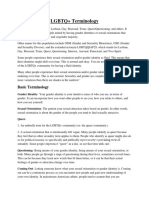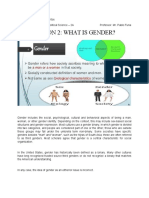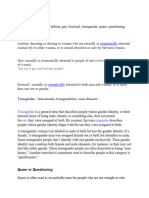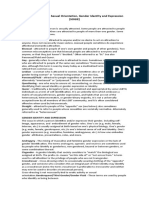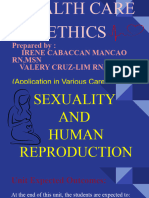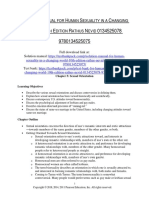Professional Documents
Culture Documents
Views On LGBT in History
Views On LGBT in History
Uploaded by
Anielou ConsigoOriginal Description:
Original Title
Copyright
Available Formats
Share this document
Did you find this document useful?
Is this content inappropriate?
Report this DocumentCopyright:
Available Formats
Views On LGBT in History
Views On LGBT in History
Uploaded by
Anielou ConsigoCopyright:
Available Formats
VIEWS ON LGBT IN HISTORY
- Sexual and emotional attraction towards the same sex has been recorded throughout history of
mankind.
In 600 BCE - they used terms ‘pleasures of the bitten peach and ‘brokeback’.
JAPAN - they have ‘shudo’ or ‘nanshoku’.
THAILAND – use the term ‘Kathoey’ to refer to lady boys.
PHILIPPINES - we have the ‘babaylan’ and the ‘catalonan’ who were mostly woman priests, but some
are males who lived their lives as women.
Society Attitude towards homosexuality and other gender variants change through history.
PEDERASTY- In ancient Greek all males are expected to take younger male lover in a practice.
BERDACHE – like the indigenous Native American, accepted and celebrated what they called ‘two-
spirited’ person in a dance to the ‘Berdache”.
SODOMY- later culture sees it as a “sin” following the Abrahamic Religion, a crime against nature.
HOMOSEXUALITY was classified as an illness in the 19th century as a basis for them to persecute
homosexuals, imprison, and commit them to a mental institution.
1973 APA removed homosexuality as psychiatric disorder or a sickness.
THE ABC’s OF THE LGBTQIA+
In an effort towards visibility and inclusion a few letters were added to the LGBT. The term
“homosexual” sounded too clinical and it no longer adequately represents the diversity within
the LGBT community.
Lesbian- women who are emotionally and sexually attracted to women.
Gay - men who are emotionally and sexually attracted to men.
Bisexual- man or woman who are emotionally and sexually attracted to men or women
Transgender- When your gender ident (how you feel) is different from your physical sex(mele/femal).
Queer- use by people who celebrate all gender identities, can also mean someone who do not want to
be restricted as Lesbian, Gay, or Bi.
Intersex- people who were born with sex genital or chromosome patterns that do not fit the typical
male or female body.
Asexual- asexual are people who do not feel sexual attraction to anyone, but it does not mean the they
do not engage in romantic or sexual relationship.
Allies are straight or heterosexual people who are fighting for LGBT rights.
Plus + - The plus sign refers to all sexualities that do not fit the LGBTQI spectrum.
UNDERSTANDING TRANSGENDERISM
-Society attaches a lot of meanings to our biological sex or physical sex.
- Parents unknowingly set a GENDER-BASED patterns of raising their children upon knowing the
biological sex of their babies.
Who is transgender?
The APA defines transgender as “an umbrella term for persons whose gender identity,
gender expression, or behavior does not conform to that typically associated with the sex to
which they were assigned at birth.”
This means that transgender person does not feel comfortable in their biological sex.
Other sexualities under the transgender umbrella term includes:
FTM – female to male, a person whose biological sex is a female and has transitioned to
living his life as a male;
MTF – male to female, a person whose biological sex is a male and has transitioned to
living her life as a female;
Crossdressing – some people want to dress as the opposite gender from time to time,
however, unlike the transsexual, they are comfortable identifying with their biological
sex;
Drag King and Queens – these are people who dress as the opposite gender for
entertainment which they do out of passion or for work; and
Gender Queer – these are people who feel like their gender does not fit the gender
binary view that is limited to the male or female category because they feel that these
are too restrictive.
The Transitioning Process
-When a person realizes that he or she may be a transgender, a psychologist can guide the
person through the transition especially when a person wants to go through permanent
changes like sex reassignment surgery.
- Transitioning to another gender is a very challenging process for many transgender people
because of the social stigma, discrimination, medical cost accessibility to treatment and
support, oppressive laws in each country and the threat of violence from prejudiced people.
You might also like
- BDSM Checklist ShevahDocument208 pagesBDSM Checklist ShevahElizabeth Cooney60% (5)
- Getting To Know You Before We Have Sex ApplicationDocument6 pagesGetting To Know You Before We Have Sex ApplicationTimothy J. Yancy80% (15)
- Essay 2 Reflection On GenderDocument6 pagesEssay 2 Reflection On Genderapi-303161275100% (6)
- Put A Finger Down - Ally Edition at Marymount School of New YorkDocument2 pagesPut A Finger Down - Ally Edition at Marymount School of New YorkThe FederalistNo ratings yet
- Gender Dysphoria Resource For ProvidersDocument17 pagesGender Dysphoria Resource For ProvidersBenjamin A Boyce71% (7)
- Lesson 13Document5 pagesLesson 13jose mari chan100% (1)
- Gender and Society ReportDocument4 pagesGender and Society ReportRIZAL-ROBBINAR ARENASNo ratings yet
- LGBT Psychology: Lopez, Dennis Acosta, John DaveDocument21 pagesLGBT Psychology: Lopez, Dennis Acosta, John DaveJake DerrickNo ratings yet
- Lesson 13Document16 pagesLesson 13Miss JhemNo ratings yet
- Lesson 10 - LGBT PsychologyDocument5 pagesLesson 10 - LGBT PsychologyAr-rafi LucmanNo ratings yet
- LESSON 9 - LGBTQ PsychologyDocument4 pagesLESSON 9 - LGBTQ PsychologyHector CandidoNo ratings yet
- Lesson 7 SspeDocument10 pagesLesson 7 SspeMa. Leonor Nikka CuevasNo ratings yet
- LGBT PsychologyDocument2 pagesLGBT Psychologyotep freecsNo ratings yet
- Template - LGBTQDocument33 pagesTemplate - LGBTQParsley Thyme Painaga HipolitoNo ratings yet
- FINAL Notes Socio 102Document5 pagesFINAL Notes Socio 102jose mari chanNo ratings yet
- LGBTQDocument21 pagesLGBTQValerie Miguel100% (1)
- G&S Lesson 10Document3 pagesG&S Lesson 10Fatima Duriza AmilNo ratings yet
- GenSoc PPT LGBT PSYCHOLOGYDocument18 pagesGenSoc PPT LGBT PSYCHOLOGYjust myselfNo ratings yet
- Group 5 LGBT PsychologyDocument28 pagesGroup 5 LGBT Psychologylemvin121003No ratings yet
- Lesson 13Document2 pagesLesson 13Jhoanna Rose AlingalanNo ratings yet
- Group 8 - Topic 10 - The A-Z of Gender - Gen&socDocument4 pagesGroup 8 - Topic 10 - The A-Z of Gender - Gen&socBandibas Faith V.No ratings yet
- Studies Teachers: President Ramon Magsaysay State UniversityDocument19 pagesStudies Teachers: President Ramon Magsaysay State UniversityIratusGlennCruzNo ratings yet
- Inbound 7410135775123024866Document6 pagesInbound 7410135775123024866Mayeth R. cananiaNo ratings yet
- Ma. Chelo Sumanting II-BSED Social ScienceDocument13 pagesMa. Chelo Sumanting II-BSED Social ScienceMa. Chelo SumantingNo ratings yet
- Gender and Sexuality: Jercules Macalinga Joel RedondoDocument11 pagesGender and Sexuality: Jercules Macalinga Joel RedondoJercules V. Macalinga IINo ratings yet
- Group 7Document26 pagesGroup 7Jay JayNo ratings yet
- LGBTQDocument17 pagesLGBTQANAMIKA YADAV100% (1)
- 3 LGBTQ TerminologyDocument4 pages3 LGBTQ TerminologyGie Apilado RanayNo ratings yet
- El 2 Gender and Society Full ModulesDocument26 pagesEl 2 Gender and Society Full ModulesLindzy Lagundino LegardeNo ratings yet
- LGBTDocument21 pagesLGBTLuna EANo ratings yet
- Module 5Document4 pagesModule 5Arnel F. PradiaNo ratings yet
- What Is Sexual Orientation?Document7 pagesWhat Is Sexual Orientation?Ronnel Remedios100% (1)
- Love and Sexuality Rev A51 1-2Document7 pagesLove and Sexuality Rev A51 1-2VivianNo ratings yet
- Gee ReviewerDocument6 pagesGee ReviewerMikel NinalgaNo ratings yet
- Gender Identity Disorder (GID)Document39 pagesGender Identity Disorder (GID)Kriselda Sangalang100% (1)
- GJFJ (M-1)Document15 pagesGJFJ (M-1)Kareena Surendra WadhwaniNo ratings yet
- LESSON2 TASK2 GEELEC4 Santos, AllyanaMarie - ABPOLSCI2ADocument7 pagesLESSON2 TASK2 GEELEC4 Santos, AllyanaMarie - ABPOLSCI2AAllyanaMarieSantosNo ratings yet
- Chapter-3.3 SOGIEDocument25 pagesChapter-3.3 SOGIEs.prosia.maviemhoniqueNo ratings yet
- Gender-And-Sexual-Orientation (1) 2Document11 pagesGender-And-Sexual-Orientation (1) 2Desiree QuinajonNo ratings yet
- Unit 1Document14 pagesUnit 1Janna Vhe AlcazarenNo ratings yet
- LGBTQUIADocument2 pagesLGBTQUIAMariano, Carl Jasper S.No ratings yet
- Janvi J LGBTQ CounsellingDocument29 pagesJanvi J LGBTQ CounsellingjanviNo ratings yet
- Pathfit NotesDocument10 pagesPathfit Notessaige sausaigeNo ratings yet
- LGBTQIA+ Rights Are Human RightsDocument13 pagesLGBTQIA+ Rights Are Human RightsI'm World Wide Handsome u know??No ratings yet
- HomosexualityDocument8 pagesHomosexualityqacsemsNo ratings yet
- Chapter 2 Gender and SocietyDocument22 pagesChapter 2 Gender and SocietyprincesssantosNo ratings yet
- Understanding Self Sex SelfDocument22 pagesUnderstanding Self Sex SelfRenan AlburoNo ratings yet
- Marriages and Familes 8th Edition Benokraitis Solutions ManualDocument32 pagesMarriages and Familes 8th Edition Benokraitis Solutions Manualedithclara2jb100% (35)
- Marriages and Familes 8Th Edition Benokraitis Solutions Manual Full Chapter PDFDocument52 pagesMarriages and Familes 8Th Edition Benokraitis Solutions Manual Full Chapter PDFPatriciaFordagkf100% (14)
- Transgender, THRD GNDR, Intersx, Bigender EtcDocument8 pagesTransgender, THRD GNDR, Intersx, Bigender EtcwaleedNo ratings yet
- Group 3 Sexual Self NewDocument22 pagesGroup 3 Sexual Self NewEdward MorbiusNo ratings yet
- A Christian Understanding of HomosexualityDocument41 pagesA Christian Understanding of HomosexualityMarcel Bas100% (1)
- Week 17 Bioethics FinalsDocument97 pagesWeek 17 Bioethics FinalsDanielaNo ratings yet
- ContractDocument2 pagesContractibanadavNo ratings yet
- Human Sexuality in A Changing World 10th Edition Rathus Solutions Manual 1Document17 pagesHuman Sexuality in A Changing World 10th Edition Rathus Solutions Manual 1michael100% (48)
- Gender IdentityDocument18 pagesGender IdentityNonito ValeNo ratings yet
- Handouts Sexual Orientation 1Document4 pagesHandouts Sexual Orientation 1Ken FurioNo ratings yet
- LESSON 1-Sex, Gender, and SexualityDocument5 pagesLESSON 1-Sex, Gender, and SexualityBernadette Shine Cabaya Calawigan100% (1)
- Lesson 1 Gender and SocietyDocument24 pagesLesson 1 Gender and SocietyMica VillagenNo ratings yet
- Gender and Sexuality: Basic TerminologyDocument2 pagesGender and Sexuality: Basic TerminologyNaj Kriztopher NoicnamaracNo ratings yet
- What Is LGBT?: LesbianDocument5 pagesWhat Is LGBT?: LesbianahlouhahNo ratings yet
- Presentation On HomosexualityDocument31 pagesPresentation On Homosexualityजब वी टॉकNo ratings yet
- LGBTQ DefenitionsDocument3 pagesLGBTQ DefenitionsgellaialmanonNo ratings yet
- Gender and Sexual Diversities BriefingDocument11 pagesGender and Sexual Diversities Briefingmohamedemam95No ratings yet
- ListDocument11 pagesListDanilo MilevNo ratings yet
- IT.12 (YUL) - Male HypogonadismDocument23 pagesIT.12 (YUL) - Male HypogonadismMikhael JHNo ratings yet
- Evidence Supporting The Biological Nature of Gender IdentityDocument6 pagesEvidence Supporting The Biological Nature of Gender IdentityMorgan Atwood100% (2)
- Class 8 - Science - Reproduction in AnimalsDocument6 pagesClass 8 - Science - Reproduction in AnimalsLucky MishraNo ratings yet
- Premarital Sex Is: Sexual Activity MarriedDocument2 pagesPremarital Sex Is: Sexual Activity MarriedJimmy Jr Comahig LapeNo ratings yet
- Signed Off Health8 q1 Mod1 Themarvelofoneself v1Document23 pagesSigned Off Health8 q1 Mod1 Themarvelofoneself v1Via Mae VirtousaNo ratings yet
- UntitledDocument276 pagesUntitledDalma BiroNo ratings yet
- Kinship by MarriageDocument11 pagesKinship by MarriageSanNo ratings yet
- Darwinian Revolution: Darwin's Five TheoriesDocument3 pagesDarwinian Revolution: Darwin's Five TheoriesMatti NoNo ratings yet
- Screenshot 2022-09-12 at 18.16.11Document1 pageScreenshot 2022-09-12 at 18.16.11Manza RaduNo ratings yet
- Gender - Responsive Basic Education PolicyDocument38 pagesGender - Responsive Basic Education PolicyJoan Tajale de GuzmanNo ratings yet
- Research ProjectDocument8 pagesResearch ProjectNivruti TagotraNo ratings yet
- Sexualitate Si CulturaDocument4 pagesSexualitate Si CulturaPorutiu-Crisan GiorgianaNo ratings yet
- Discipline and Ideas of Social Science: Deona Faye PantasDocument39 pagesDiscipline and Ideas of Social Science: Deona Faye PantasDeona Faye PantasNo ratings yet
- The Heterosexual Questionnaire: Attributed To Martin Rochlin, Ph.D. January 1977Document2 pagesThe Heterosexual Questionnaire: Attributed To Martin Rochlin, Ph.D. January 1977Maria Cristina Ardila CorreaNo ratings yet
- Annex 3 - Dairy Cattle ManagementDocument62 pagesAnnex 3 - Dairy Cattle Managementnjuguna63100% (2)
- The Books Will Be Paired in Pairs "Sex Positions and Tantric Sex" and "Dirty Talk and BDSM". We Create Two SUBTITLE and Only Two DESCRIPTIONS! Template For Briefs For Ghost Writing CompaniesDocument28 pagesThe Books Will Be Paired in Pairs "Sex Positions and Tantric Sex" and "Dirty Talk and BDSM". We Create Two SUBTITLE and Only Two DESCRIPTIONS! Template For Briefs For Ghost Writing CompaniesChristine GomezNo ratings yet
- 057 - Endocrinology Physiology) OvulationDocument4 pages057 - Endocrinology Physiology) Ovulationhasanatiya41No ratings yet
- Module 5 Enrichment TaskDocument1 pageModule 5 Enrichment TaskAngelyn CayabanNo ratings yet
- Gen IticsDocument148 pagesGen Iticskb gagsNo ratings yet
- 561117sacasc87 365 Sex PositionsDocument388 pages561117sacasc87 365 Sex PositionsAlexandr TrotskyNo ratings yet
- Common Terms Used To Discuss GenderDocument2 pagesCommon Terms Used To Discuss GenderBogdan MariaNo ratings yet
- Significance or Applications of Mitosis/Meiosis: General Biology 1Document26 pagesSignificance or Applications of Mitosis/Meiosis: General Biology 1beaNo ratings yet
- Critical EssayDocument5 pagesCritical EssayJacqueline Joy BurroughsNo ratings yet
- Republic of The Philippines Vs CagandahanDocument3 pagesRepublic of The Philippines Vs CagandahanSheng EyyNo ratings yet



























